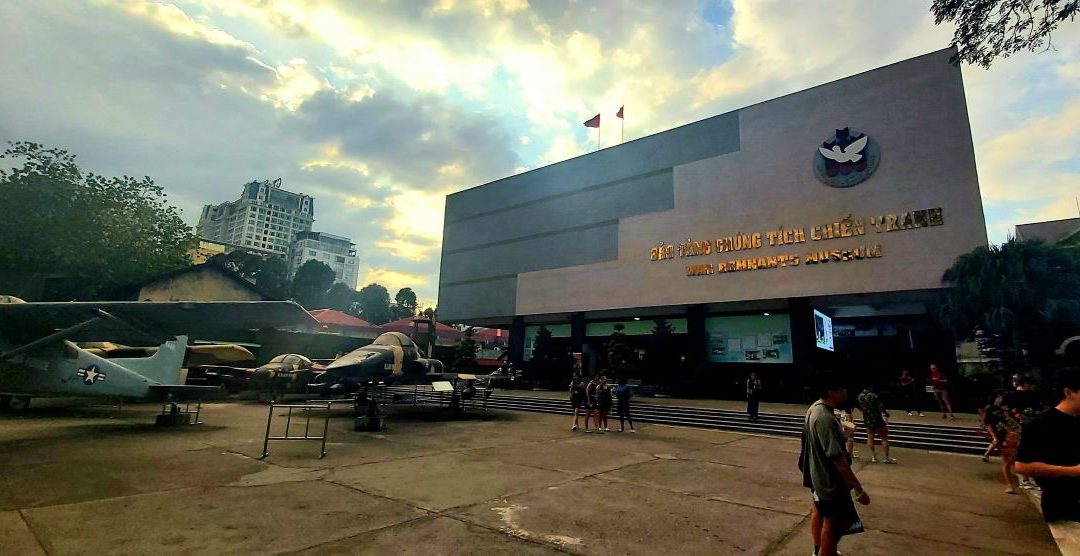This is the fourth in our series about the most popular tourist sites in Ho Chi Minh City. This one visits the thought-provoking War Remnant’s Museum.
After reviewing my series of self-guided walking tours around Ho Chi Minh City, I realized that independent travelers probably need more information to understand these interesting sites. So here’s number 4.
Click the link to find number 1, Saigon Notre Dame Cathedral,
And number 2, Reunification Palace.
And number 3, Saigon Opera House
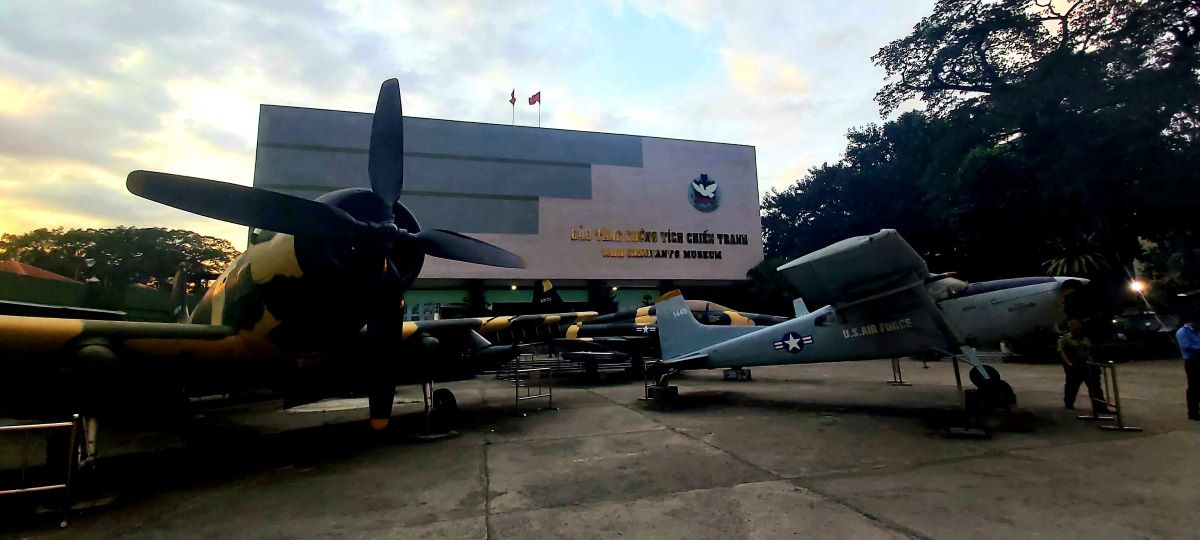
Fighter Planes grace the entrance
Rated as number 2 of 316 things to do in Ho Chi Minh City (by members of Tripadvisor – December 2023), Saigon’s War Remnants Museum remains as unapologetically candid as ever.
It would be rare for someone to visit this collection and walk out unaffected. This is one city museum that should be on every itinerary for Vietnam.
Both Tim and I have been to see this museum 4 (maybe 5) times each at different times.
The first visit was in 1997, at the beginning of a month-long trip through Vietnam. It was before we knew much about the Vietnam War besides what was skimmed over in history class in Australian high schools. I distinctly remember it was one of the most meaningful and confronting collections I’d ever seen.
We’ve since escorted many friends and family who’ve come to visit Saigon. While the museum’s layout has changed a bit over the years, the exhibits haven’t lost any of their impact.
My (Shazz) most recent visit was Christmas 2023 to check that things were still organized as I remembered and grab some pictures to update this post.
The museum, which I consider one of the world’s best war museums, never ceases to anger, sadden, and frustrate me.
Angered because the actions taken by Western powers before, during, and after the Vietnam War were abhorrent. Neither side were angels, but my goodness – the US, French, and allied governments have a LOT to answer for.
Saddened because of the suffering endured by the people on both sides, but in particular, the Vietnamese.
And frustrated because current world events show the world hasn’t learned from the complete shitshow.
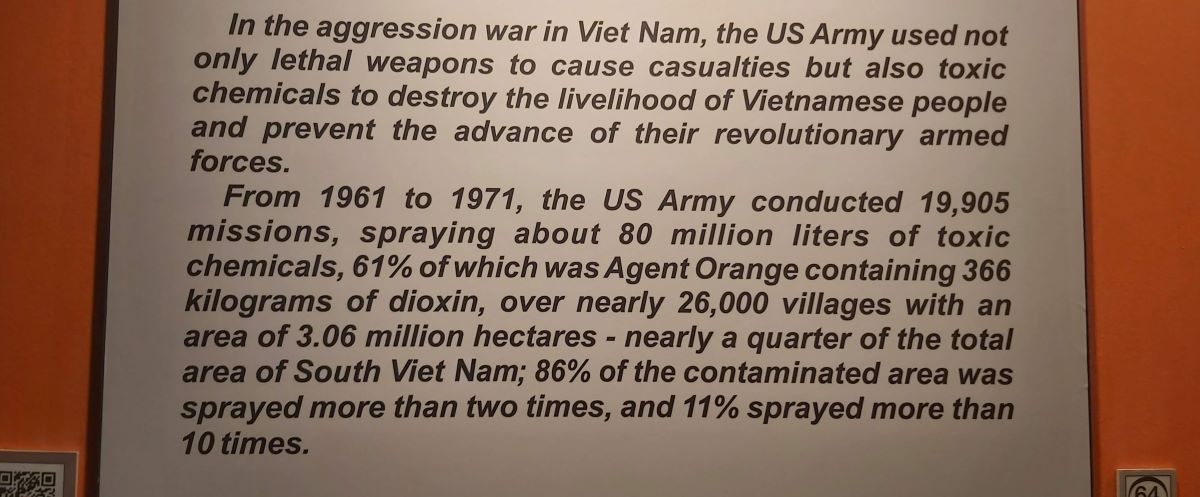
How can this be right?
History of the War Remnants Museum
Over the years, this building has had several names. How confrontational they have been is directly related to the status of diplomatic relations with the United States at the time.
When it opened in 1975, in the former US Information Agency, it was titled the “Exhibition House for US and Puppet Crimes”.
In 1990, as relations between the US and Vietnam thawed, it became the “Exhibition House for Crimes of War and Aggression.”.
It changed to its current title in 1995 when the normalization of diplomatic relations with the United States occurred, and the US dropped embargos on the country.
I’ve seen some reports that was also called the Museum of Chinese and American War Crimes, but I can’t confirm that. And, I was sure that it was called the “Museum of American War Atrocities” in 1997. Perhaps that was just my mindset after visiting for the first time.
The Vietnamese name for the Museum is Bảo tàng Chứng tích Chiến tranh.
Where Can You Find the War Remnants Museum?
You can find the main entrance of the War Remnants Museum at 28 Vo Van Tan Street, in District 3 (Right on the northern edge of District 1). There’s another side entrance on Le Quy Don street.
It’s just up the road from Tao Dan Park, one of Ho Chi Minh City’s most pleasant green spaces. Walk 5-minute (???m) south and you’ll find the Reunification Palace (Independence Palace), Saigon Central Post Office, and Notre Dame Cathedral.
Hence, you can easily incorporate a visit into a 1-day itinerary walking around Ho Chi Minh City.
Address: 28 Vo Van Tan Street, P6, District 3, Ho Chi Minh City, Vietnam
Phone: +84 82 2030 682 – +84 28 3930 6325
Email: truyenthong.btctct@gmail.com
Website: The website has an English version. https://baotangchungtichchientranh.vn/?language=en
When Can You Visit?
Opening Hours: The War Remnants Museum’s opening hours are from 7.30 am to 5.30 pm daily, including public holidays. The ticket counter closes at 5 pm.
How Much Does It Cost To Visit?
Ticket Prices (in 2023): 40 000 VND
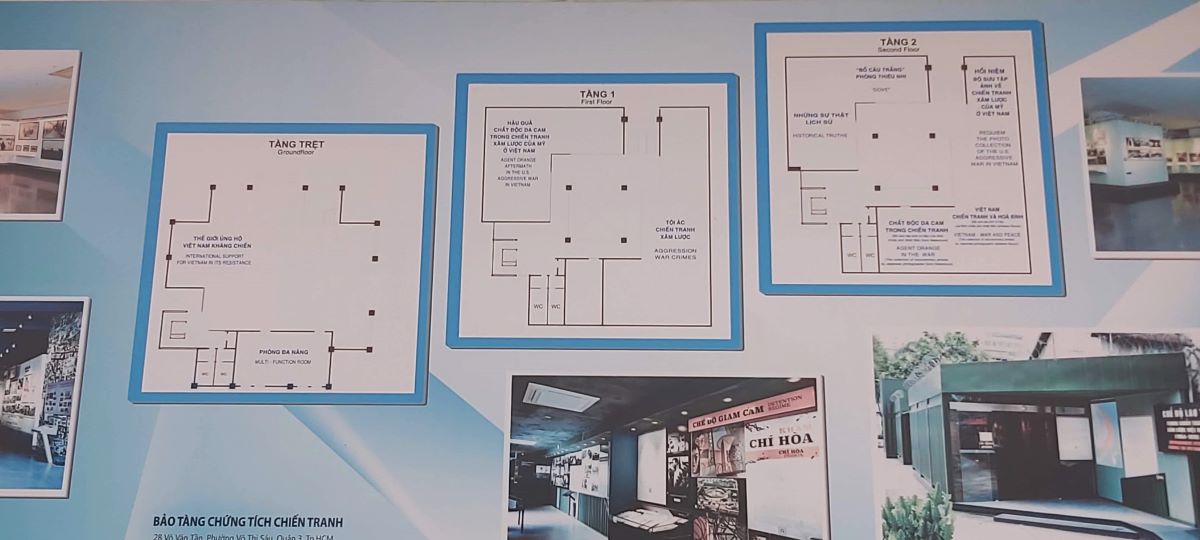
There is a better floor plan at the entrance, I just forgot to take a proper picture. Doh!
The Best Way To See the War Remnants Museum
There are over 1500 exhibits on display, organized under eight themes. They are not all directed at the “American War”. There are exhibits relating to the First Indochina War (French occupation) and other conflicts as well.
The museum is well laid out in numbered sections and has plenty of information on all of the displays in both Vietnamese and English.
There are also audio guides available on the ground floor, so it’s relatively easy to see independently.
However, if you’d prefer to take an expert with you and combine your visit as a tour of Ho Chi Minh City with other sites such as Independence Palace and Cu Chi Tunnels, consider one of the following tours.
Finish up with the ‘Tiger Cages’ on the east side of the building.
Outside Exhibits
In the yard surrounding the building, you can find a bunch of planes, tanks, and artillery pieces from the Vietnam War, which you are free to wander around and examine. There are information boards with text in English.
The military equipment includes a UH-1 (Huey) helicopter, F-5A fighter, A-1 Skyraider attack bomber, and A-37 dragonfly attack bomber used by the US Air Force. You’ll also find a M48 Patton tank.
There’s also some unexploded ordinance around. But don’t worry, it’s been disarmed.
Another interesting exhibit is the bell made from a 500 lb bomb cannister. The bell was originally part of Buu Lam Pagoda in Binh Thuan Province. Bodies of the dead caused by US bombs were carried to the temple before being received by their families. There were no materials to make a bell for the original temple, so the locals used the unexploded bomb. In 1994, the temple raised enough funds for a new bell. The old bell was passed to a collector and then onto the Museum in 2020.
Inside Exhibits
As I said, walk in the front door. You’ll see the audio guides to your left and the gift shop to the right. There are also a couple of rooms with exhibits. But head straight up to the second floor, and we’ll return to those later.
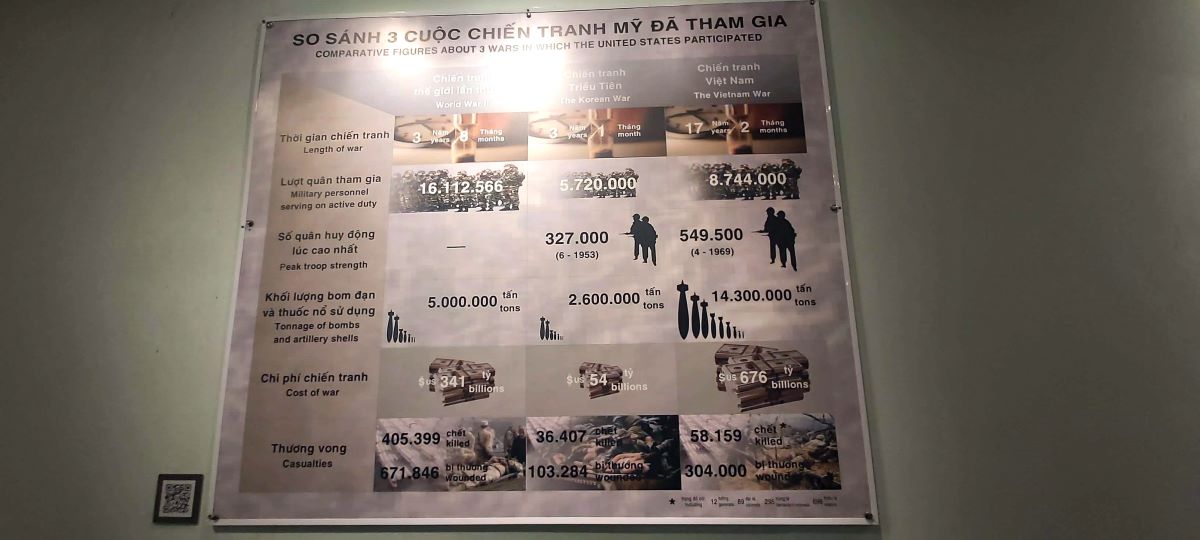
That's A LOT of bombs!
Historical Truths – Room 1 – Level 2
You’ll find room 1 to the right as you come up the stairs.
Start at the large picture showing Ho Chi Minh and an excerpt from the ‘Declaration of Independence of the Democratic Republic of Vietnam’ on September 2nd, 1945. This statement sets the scene for the rest of the room, which gives a comprehensive overview of US support for the French and South Vietnamese governments.
In a nutshell:
-
The French refused to leave Indochina peacefully.
-
The North Vietnamese fought back in a resistance war.
-
The US got involved because they didn’t want to lose access to the resources in the area, and the whole Yellow Peril thing was going on.
-
When the French finally left in 1955, the US propped up the corrupt South Vietnamese Government of the time.
-
They broke international treaties and agreements and tried to ‘cleanse’ South Vietnam of the Viet Minh (League for the Independence of Vietnam)
-
When that didn’t work, and the Vietnamese people fought back, the US used a false flag (The Gulf of Tonkin in 1964) as a pretense to put boots on the ground in 1965.
-
Over the course of the next 10 years, they:
-
spent an astronomical amount of money (676 billion),
-
had almost 9 000 000 troops on active duty with a peak strength of 549 500 troops (58 189 killed, 304 000 casualties), and
-
dropped 14 300 000 tons of bombs and artillery shells.
If that doesn’t make you mad, head on over to Room 2.
Requiem – Rooms 2,3, and 4 – Level 2
This room contains the ‘Requiem Exhibition,’ an incredible collection of 204 pieces of work by 133 photojournalists of 11 nationalities (western and Vietnamese) who reported in Indochina.
The collection was first published by war photographer Tim Page and German photojournalist Horst Faas in November 1997.
If it wasn’t for these brave men (and women) recording the atrocities and sheer horror of the war, the general population of the allied nations may never have woken up to how terrible it was and forced Western politicians to change course.
In the center of the room is a collection of documentary pictures by Japanese photographer Shikawa Bunyo
And further on you’ll find a collection of photographs from Goro Nakamura showing the hideous effects of Agent Orange and other chemical weapons used by the US and its allies. As horrifying as they are, they are just a primer for room 6 on the first floor.
So head on down.
(Note: Room 5 is a children’s education and activity room for students and isn’t open unless there’s a group in.)
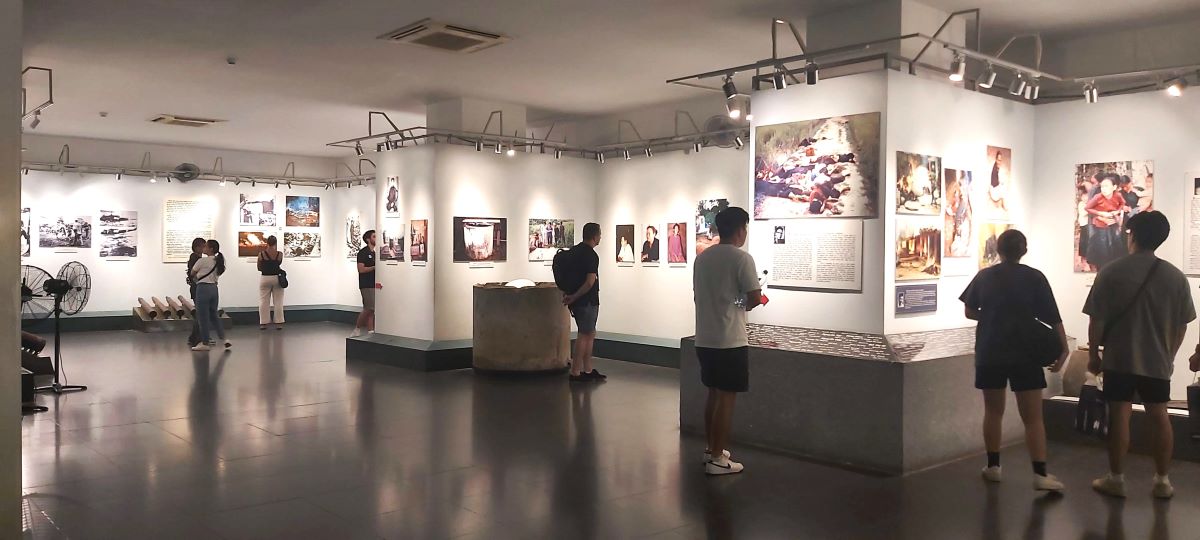
The aptly named War Crimes room at the museum.
War Crimes – Room 6 – Level 2
If you’re not already horrified by what happened during this war, this room is about to make it even more real. Between the massacres, torture, American atrocities, experimental weapons, and use of chemicals on both the countryside and humans, these exhibitions exposing war crimes don’t leave much to the imagination.
Exhibits include graphic photography of chemical warfare (Agent Orange, Napalm and phosphorus bombs) used by the United States and several massacres, the horrifying My Lai massacre being just one.
A quote in Le Figaro, April 25th, 1965, sums it up.
“Vietnam has become an experimental place for all inventions from US military engineers. Their purpose was to use living targets to test their inventions for later use in other battles.”
Disturbingly, even though there is plenty of evidence of the many war crimes and complete disrespect for the Geneva Convention, no one has ever been charged.
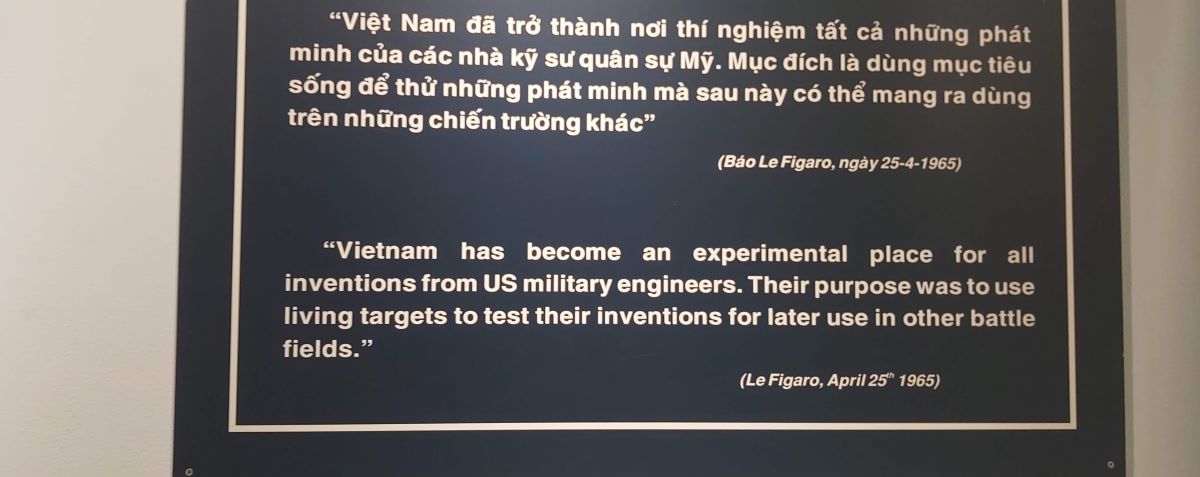
So sad but true.
Agent Orange Effects – Room 7 & 8 – Level 1
One particularly disturbing part of the museum (for me, at least) is the part covering the effects of Agent Orange and other chemical defoliant sprays, both during the war and in subsequent generations.
The chemicals were used to defoliate large tracts of Vietnam with the hope of flushing out the Viet Cong.
The high concentration of deadly dioxins contained in the defoliant Agent Orange has wreaked havoc for generations since. Even though the victims were mainly Vietnamese, veterans from the US and allied countries were also impacted.
Pharmaceutical companies have paid out some compensation to US vets but have never admitted liability for the damage done to Vietnamese victims.
You’re probably pretty shell-shocked by now, but there are still a few more things to see. So head on down to the first floor.
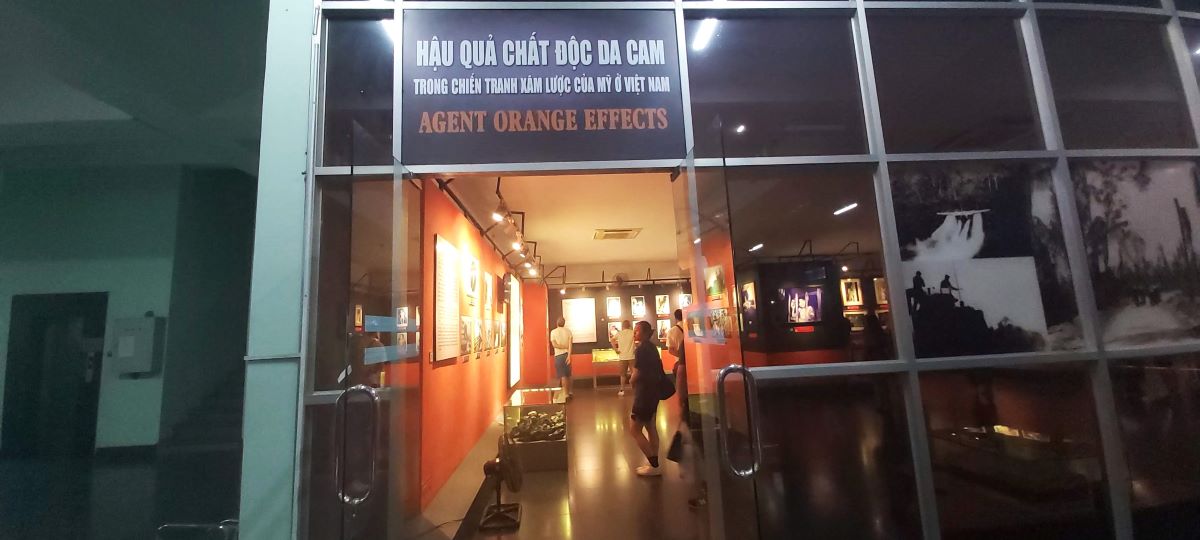
A whole room on the devastating effects of Agent Orange.
The World Supports Vietnam in Its Resistance to US Aggression – Room 10 – Ground Floor
The exhibits are a little cheerier on this floor. The back right section shows all of the countries and organizations that supported Vietnam in its quest for independence and reunification.
Plastering the walls are posters and photographs of the antiwar movement around the world, which I found somewhat of a counterbalance to the horrors and widespread destruction displayed in many of the other rooms.
Temporary Exhibits – Room 11- Ground Floor
The left-hand side of the ground floor is used for temporary exhibitions. The last time I visited, the exhibit was “Remembrance of Resistance Days.” which presented personal narratives from former political prisoners and war veterans about their experiences in various South Vietnamese prisons.
Ok…You’re almost there.
If you want to pick up a memento, ‘Exit via the gift shop.’
Then head outside and turn to your right to explore the “Tiger Cages” and prison cells to the side of the building. These were used by the South Vietnamese government to detain and torture political prisoners in the resistance war.
Tiger Cages
The infamous tiger cages were small wire boxes that were too small for prisoners to stretch out or lay properly. The thin wire would cut into their flesh, blistered by the scorching sun.
The most infamous prisons where the tiger cages were used include those on Con Dau and Phu Quoc Islands.
Other curiosities include a guillotine used to execute prisoners
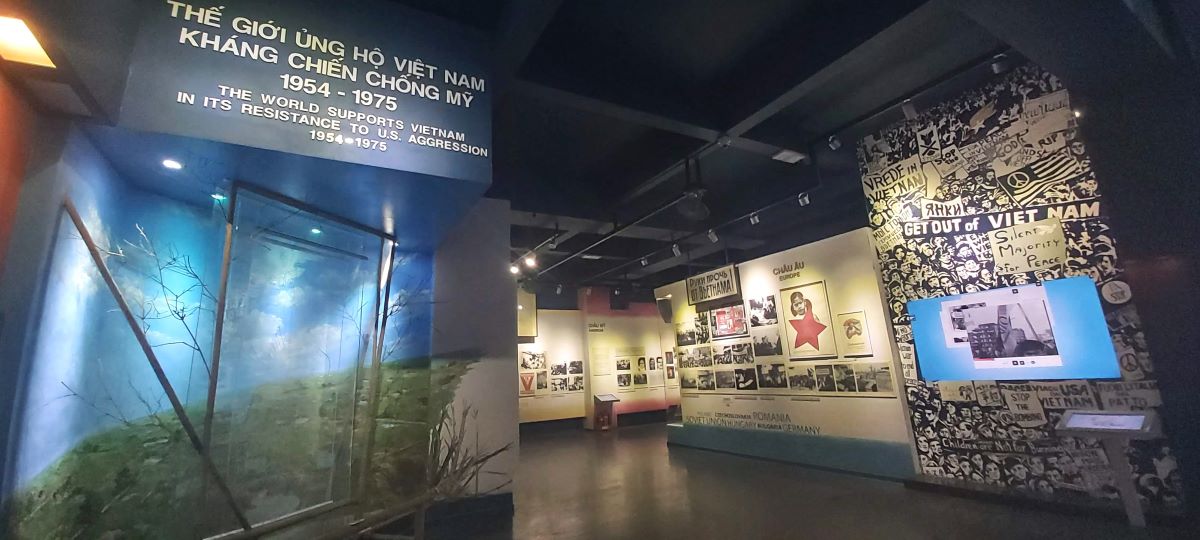
There was a LOT more support for Vietnam than some governments would have you believe.
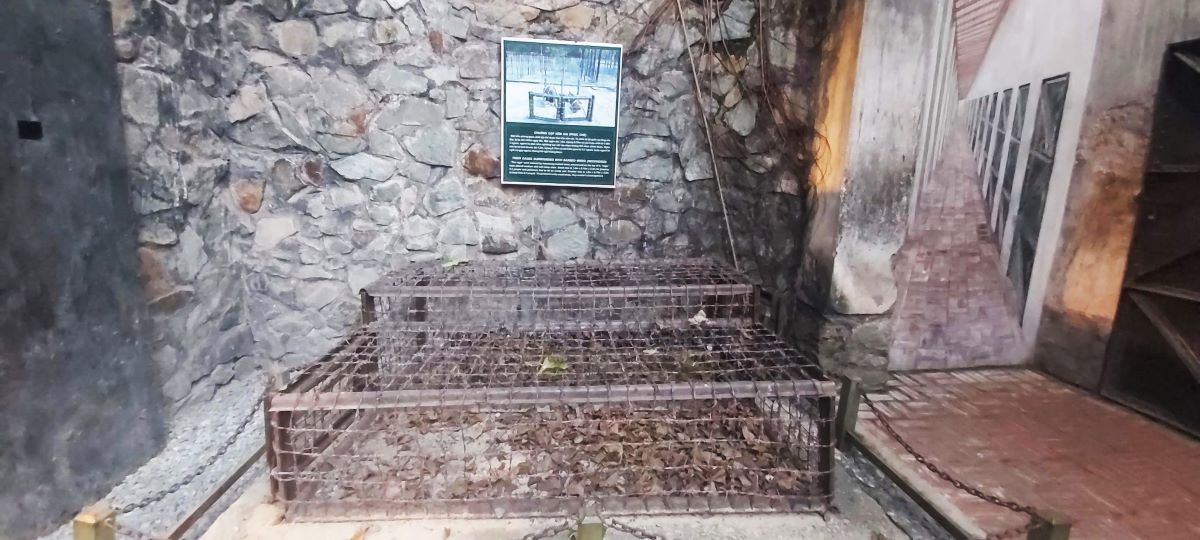
A 'Tiger Cage' used to imprison Political prisoners in South Vietnam
We Should Never Forget The Realities of the Vietnam War
According to official estimates, this museum succeeds in attracting approximately half a million visitors a year. Two-thirds of them are foreigners.
Some visitors may feel the museum is one-sided and essentially propaganda by the victors.
Personally, I think it’s one of the best museums in Vietnam. And, it’s important that Vietnam’s side of this terrible war is represented, and we acknowledge the abhorrent acts committed by the Western powers against other men (women and children!!!)
Admittedly, bad things were done by both sides, but I ask the question. Can you see the Vietnamese side of the story in any American or French museum? I honestly don’t know, as I haven’t visited, but I doubt it. I would love to stand corrected by someone who knows, so please comment below.
Like it or not, you can’t deny this museum is very successful in exposing the realities of war and is an integral part of Vietnam’s history. It’s full of photographic and factual evidence of the horrific nature of war and its impact on the nation.
It also shows what grit and determination can do against much better-resourced forces. It really was a David and Goliath battle.
The real issue I have is that we seem, as a species, not to have learned any of the lessons from the past.
We continue to inflict pain and suffering on innocents as we wage war in the name of freedom and religion, when most times it’s self-interest and greed.
If the museum makes you feel a little uncomfortable, then that’s not such a bad thing. Maybe as a whole, we can influence our governments to stop using aggression to solve “problems”.
The positive thing for me is there appears to be very little resentment among the current generations of Vietnamese. Visitors, including Americans, are welcomed with open arms, warm hearts, and overwhelming hospitality to this country.
I strongly encourage everyone who passes through Saigon to visit the War Remnants Museum, learn about what happened, and then form your own opinion on how you feel.
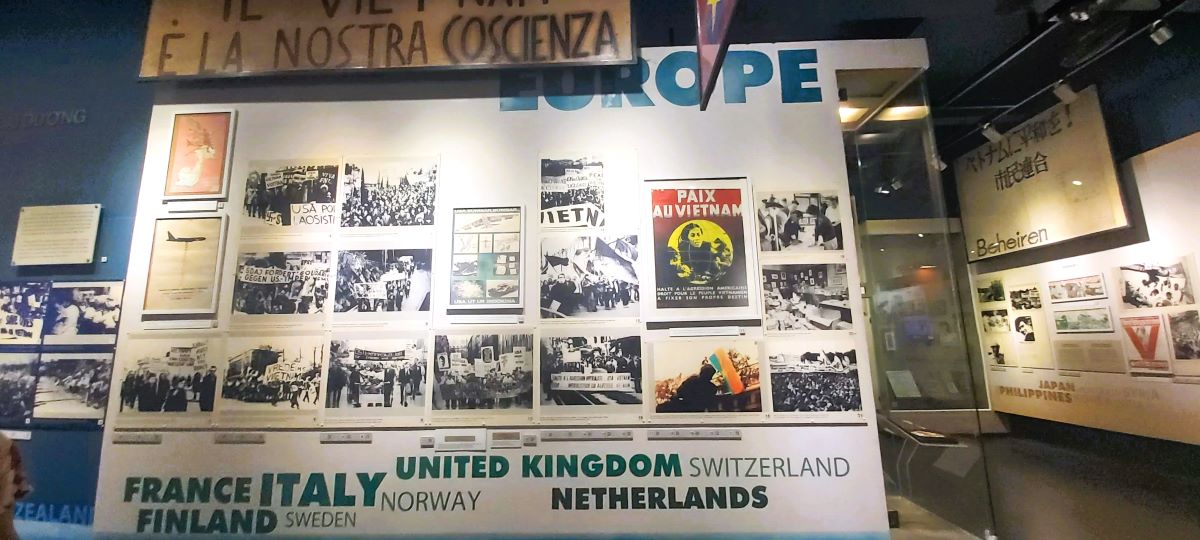
Posters protesting the US involvement in the Vietnam War
What Next?
The War Remnants Museum is a must-see for Ho Chi Minh City visitors. But there’s a lot more to see.
Check out my 1-day self-guided Walking Tour of all the most popular sites, including Independence Palace, Saigon Notre Dame Cathedral, and Ben Thanh Market.
You’ll find instructions on how to coordinate it yourself, but lots of tour options as well.
Then, if you have more time, take a look at days 2, 3, and 4 to explore the less-visited but still interesting attractions.
And, if this is your first visit to Vietnam and Saigon, then take a look at our:
Vietnam Page – where you’ll find lots of practical information to plan and execute the perfect trip and
The Ho Chi Minh City Visitor’s Information page for everything you’ll need during your stay.
Vietnam Travel Guide
Traveling to Vietnam but don’t know where to start? This travel guide has everything you need to start planning your adventure in this amazing country.
Lonely Planet Vietnam
Lonely Planet’s Vietnam is your passport to the most relevant, up-to-date advice on what to see and skip, and what hidden discoveries await you.
Rough Guide Vietnam
A practical travel guide to Vietnam featuring detailed travel tips and points of interest, lists of all iconic must-see sights, and off-the-beaten-track treasures.
Heading to Vietnam Soon?
Check out our Travel Resource pages before you start planning and booking. Everything you need in one place to save you money and travel better.
And more…
Book Your Flight
Use WayAway to find cheap flights. They are our favorite search engine because they search websites and airlines around the globe. (Including the tiny budget ones many other search engines ignore.)
Book Your Accommodation
To find the best deals and book most of our accommodation (when we’re not housesitting,) we use:
-
- WayAway
- Booking.com, and
- Agoda
If you are more into Hostels, then Hostelword is the biggest platform for those.
Don’t Forget Travel Insurance
Travel insurance will protect you if anything goes wrong before or during your trip. We never travel without it and have needed it many times. We’ve used a few companies with excellent results over the years.
Consider:
- Covermore (Australians)
- Safety Wing (All nationalities. Great for long-term travelers and Digital Nomads.)
- World Nomads (All nationalities. Great for long-term travelers and Digital Nomads.)
- Visitors Coverage (to see a more extensive range of available plans from different providers, including policies for over 60’s.)

